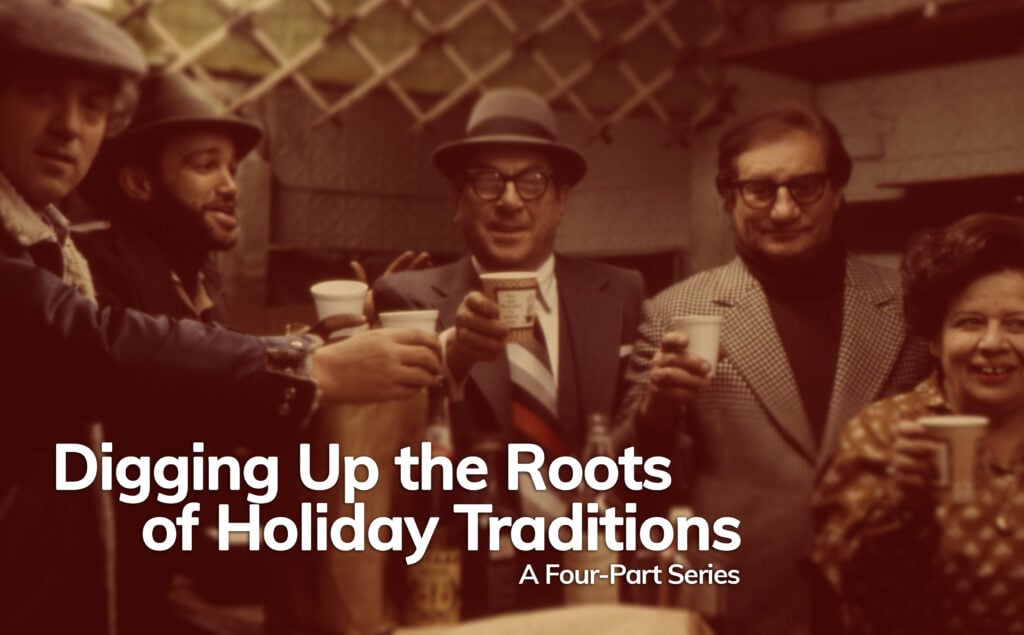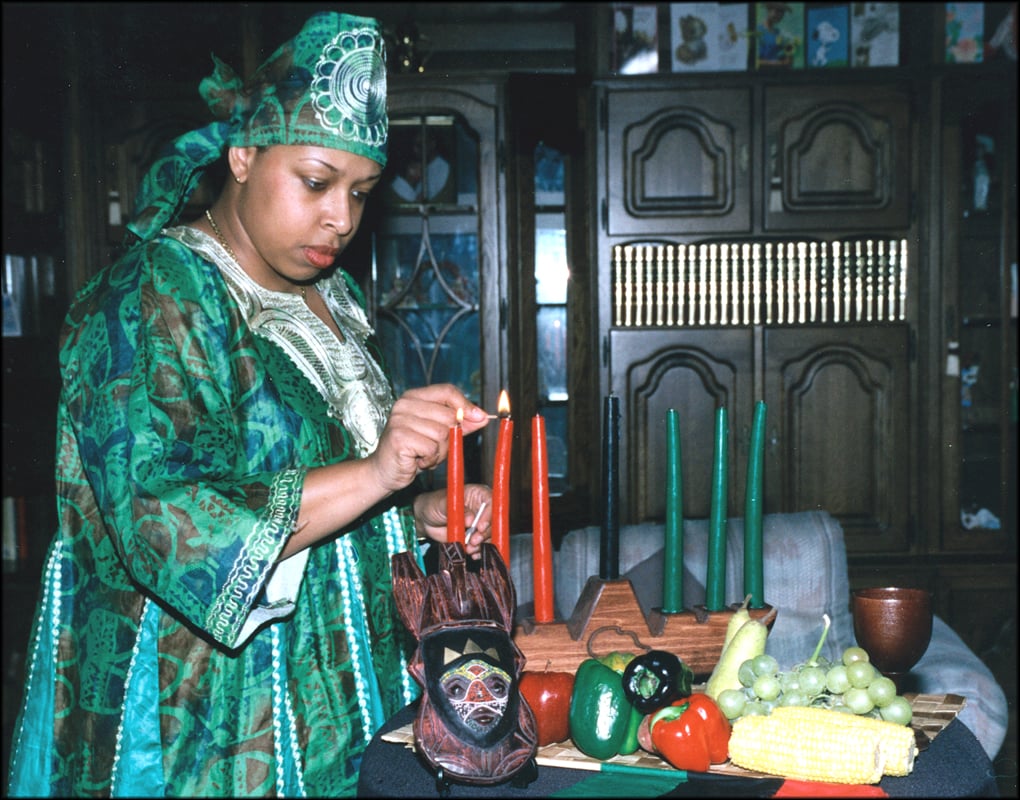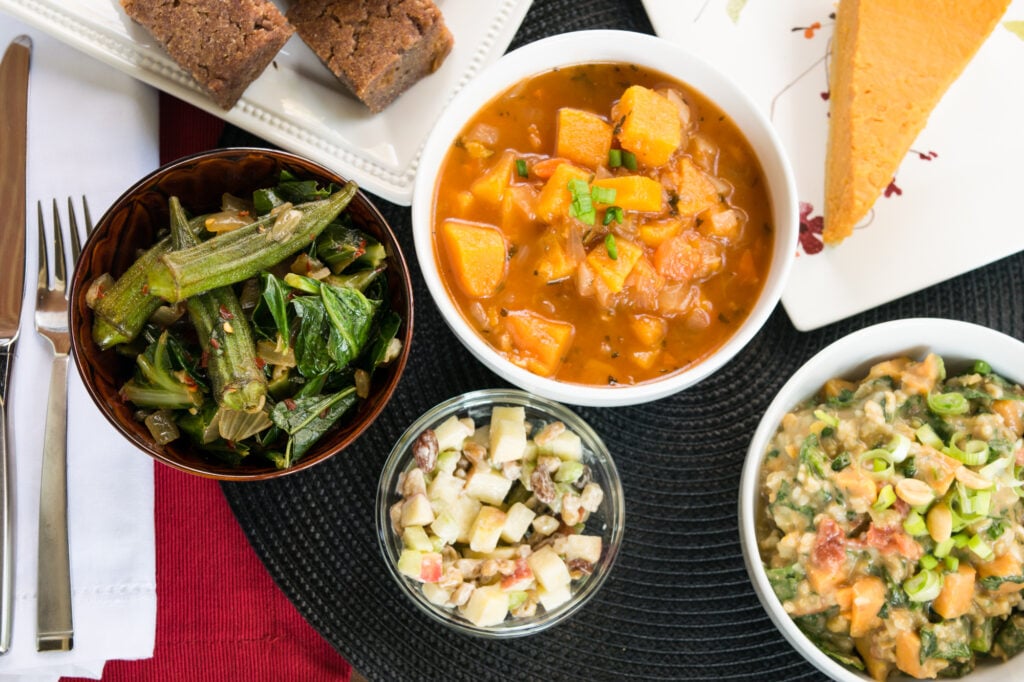Join us as we discover the origins of your favorite (or least favorite) holiday food traditions. This four part series will unwrap the ways these traditions have become integrated into our culture and helped shape our American identities. Read Part I: Hanukkah now.
Food History, Great Reads
Digging Up the Roots of Holiday Traditions: Kwanzaa

Habari Gani! It means, “What’s new?” in Swahili and is a common greeting among those that observe Kwanzaa. Most of us are familiar with Kwanzaa, but may not know how it came to be or why it is particularly significant. Kwanzaa is a relatively new holiday, but no less important than Christmas and Hanukkah. Like many holidays it focuses on honoring history and heritage. Kwanzaa came into existence as a political, social, and cultural response to the Black American experience. It focuses specifically on empowering Black people and remembering Black perseverance in the face of continued struggle and applauding Black achievement.
While the struggles of the past were the bonds of slavery, Kwanzaa remains pertinent after George Floyd’s death at the hands of the police sparked a new wave of Black Lives Matter protests. These protests highlighted the systemic racism that enables police brutality to persist to this day. Many of us have tried to educate ourselves in an attempt to become better allies in dismantling systemic racism. Kwanzaa’s food traditions are not the be all and end all of Kwanzaa. They are an effective avenue for examining Black American heritage. The food we prepare and eat symbolizes familial affection and personal histories. While the way we connect this year may be more virtual than years past, something as simple as great grandma’s sweet potato casserole both reveals our roots and makes our faraway loved ones feel much closer. With that said before we dive into Kwanzaa’s culinary offerings, a little more context on Kwanzaa’s history and its role in Black culture is due.
Kwanzaa is not a religious holiday. It was created by scholar and activist, Maulana Karenga, in 1966 as an alternative to Christmas. However, many families choose to celebrate both. Though Kwanzaa was created for Black people, it is not celebrated by all Black people. It is a seven day celebration that unites the black community on a basis of shared cultural heritage.
Kwanzaa is derived from the Swahili phrase, “matunda ya kwanza,” which means “first fruits.” While Kwanzaa is not observed in Africa, it is inspired by harvest celebrations during which various ethnic groups will gather as a community or village after the harvest to give thanks for their bounty. Kwanzaa places emphasis on honoring African heritage through dance, music, poetry, and story-telling and presents families with an opportunity to educate their children on their ancestral roots.

When people think of Kwanzaa they typically picture a candelabra with black, red, and green candles. But while the candle lighting ceremony is integral to Kwanzaa, there is a lot more to Kwanzaa than that. Several symbolic items feature prominently on dining tables. They include Kinara, a candle holder; Mishumaa Saba, seven candles; Mkeka, the mat; Mazao, crops; Muhindi, ears of corn; Kikombe Cha Umoja, a unity cup; and Zawadi, gifts.
The mkeka is a straw mat which represents that tradition is the foundation for the home and the values it celebrates. Mazao are fresh fruits and vegetables that are placed on the table to represent a bountiful harvest. Muhindi, ears of corn, represent the children of the family. The zawadi symbolizes the fruits of one’s labor.
The seven core principles, Nguzo Saba, touch on the importance of community, family, and culture. These seven principles include umoja, kujichagulia, ujima, ujamaa, nia, kuumba, and imani. Translated they mean unity, self-determination, collective work and responsibility, cooperative economics (building and supporting black businesses), purpose, creativity, and faith. A candle is lit each night to represent each of these pillars. The candles are three different colors that correspond to different meanings. Black represents the color of African peoples everywhere and is located in the center. Three red candles represent the blood of the ancestors and are placed to the left. The three green candles symbolize the earth, life, and the ideas and promise of the future, and are placed to the right. After the candle lighting, a discussion on the principle of the day takes place. The final day is known as Karamu, when a lavish feast is held and gifts may be distributed to children.
Unlike other holidays, there are no hard and fast rules as to what constitutes Kwanzaa fare. Kwanzaa food is any dish that people choose to prepare to celebrate the holiday, varying depending on region and a family’s background. For some families it may reflect their forced migration and for others their immigration. Those from the South will likely think of red beans and rice or sweet potatoes, smothered green beans, collards cooked with ham hocks, black-eyed peas, and other soul food typical of Southern cooking. Those with Ghanian roots might cook up groundnut stew accompanied by jollof rice. There may be Philadelphian pepper pot stew or Senegalese thieboudienne. Starches may include anything from rice or couscous, candied yams, buttermilk biscuits, spoonbread, plantains, fritters, hoppin’ John, or injera. Some families even use Kwanzaa as an opportunity to explore different African cuisine. As Kwanzaa is a holiday focused on community, the most important thing is that the meal is shared with others.

Despite regional differences, what the foods prepared share in common is a focus on beans, starches, grains, and greens. It should be noted that much of the grains and produce that are staples of Southern American cuisine came from Africa through trans-Atlantic slave trade. Southern cuisine was largely crafted by often undercredited enslaved cooks for white plantation owners, explaining the similarities in flavor profile and preparation.
Michael Twitty, culinary historian and food blogger of Afroculinaria, interprets the seven principles beautifully giving them an additional layer of richness. When defining ujoma, or unity, he says, “We are one astonishing people with a global food tradition that is remarkable for its distinctiveness but even more remarkable for its unified sense of flavor, composure, aesthetics and types of ingredients.” Thus it does not matter if some eat collards and others eat calaloo or gumbo or oxtails. His interpretation means that despite differences in traditions and recipes there are shared values and a collective cultural sensibility.
But the lack of an emblematic Kwanzaa dish does not mean the food is unimportant or lacks meaning. Kwanzaa, like all other holidays, is an opportunity for families to gather for a meal and spend time together while rejoicing and honoring their African heritage. The dishes prepared and eaten during Kwanzaa serve to reflect the history of the families preparing it and tell a story about their own journey and that of their ancestors before them.
It is a story of hardship but also one of resilience. Frank Dobson, associate Dean of Vanderbilt University, writes of Kwanzaa, “Like the black power movements, such as today’s Black Lives Matter movement, it is an affirmation of ‘Black folks’ humanity,’ their ‘contributions to this society’ and ‘resilience in the face of deadly oppression’.” Kwanzaa serves as a tool to rejoice in what it means to be Black, a meaning that is still relevant today. It is also a time to unite and reflect on the suffering endured under slavery and find power in a shared sense of identity.
Eric Copage, author of Kwanzaa: An African-American Celebration of Culture and Cooking, writes how his decision to celebrate Kwanzaa stemmed from a desire to educate his son: “I wanted him to understand that through tenacity, hard work, and purposefulness — all of which are grounded in the African and African-American ethos — blacks have flourished as well as survived.” Holidays like Kwanzaa and the food traditions surrounding them act as a lens for which we can examine our origins and take pride in what we find. They help inform us who we are and what we value.
Stay tuned for Part IV: Lunar New Year out now!
Images:
-
Header: Tenement Museum collections
-
Tech. Sgt. Jennifer Myers (above), 66th Air Base Wing noncommissioned officer in charge of the Military Equal Opportunity office, demonstrates a Kwanzaa ritual where she lights a candle in the Kinara. 2005. U.S. Air Force
-
Kwanzaa meal, USDA
Sources:
-
Ali-Dinar, Ali. 1990. “Kwanzaa- What Is It?” Kwanzaa- What Is It? University of Pennsylvania. March 1990. https://www.africa.upenn.edu/K-12/Kwanzaa_What_16661.html.
-
CNN, Leah Asmelash. 2019. “The Seven Principles of Kwanzaa.” CNN. December 26, 2019.
-
Diskin, Esther. 1994. “CELEBRATING KWANZAA: THE 7 PRINCIPLES ‘IF YOU DON’T KNOW WHO YOU ARE, ;YOU CAN’T HAVE SELF-ESTEEM.’” The Virginia Pilot, December, A1.
-
Dobson, Frank. 2017. “What Kwanzaa Means for Black Americans.” The Conversation. December 20, 2017
-
Giuca, Linda. 1991. “DURING KWANZAA, FEAST ON AFRICAN FOOD, CULTURE.” Hartford Courant, December 25, 1991.
-
Handley-Cousins, Sarah, and Marissa Rhodes. “Slavery & Soul Food: African Crops and Enslaved Cooks in the History of Southern Cuisine.” Dig. Podcast audio, July 26, 2020.
-
Hopkins, Tonya. 2019. “The Fascinating—and Delicious—History of Kwanzaa Celebrations in Philadelphia.” Podcast. The Philadelphia Citizen. Philadelphia Citizen.
-
Martin, Michael. 2011. “Food Bloggers Take A Bite Out Of Kwanzaa.” Radio show. NPR.
-
McCarthy, Kelly. 2019. “Kwanzaa Starts Today, Here’s Everything You Need to Know about the Week-Long Holiday.” ABC News. December 26, 2019.
-
“The Meaning of Kwanzaa.” n.d. Smithsonian Anacostia Museum. Smithsonian. Accessed October 26, 2020.
-
Twitty, Michael. 2011. “Reminder: Kwanzaa Principles and Food.” Afroculinaria (blog). December 29, 2011.